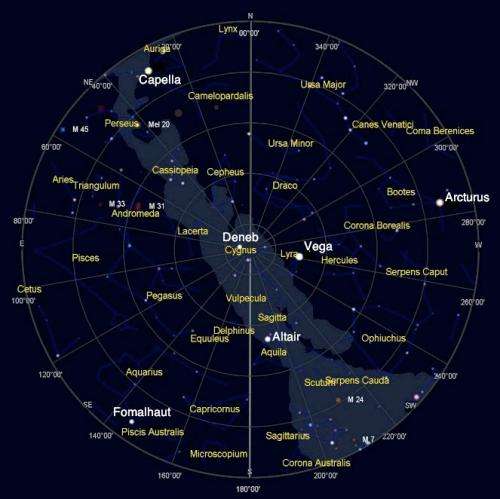Northern Rockies skies for September

The early September night sky is dominated by the summer triangle (Vega, Deneb and Altair) directly overhead. The constellation Scorpius lies on the southwest horizon with its brilliant red star, Antares.
Overhead, the Northern Cross or Cygnus, "the swan," is embedded in the summer triangle. The other constellations that lie in the plane of our galaxy are Cepheus, Cassiopeia and Perseus, located on the northeast horizon. The plane of our Milky Way galaxy stretches from the southwestern horizon, arching up directly overhead and plunging eastward on the northern horizon.
Two of the most prominent constellations in the September skies are Andromeda, "the princess," and Pegasus, "the winged horse." Pegasus can easily be spotted since its body is dominated by the famous Great Square of four stars.
Planet watch: Right after sunset you can see Saturn and then Mars, but they set within one hour or two. Jupiter rises at midnight, so keep an eye on this giant planet. Venus remains the morning star rising in the east around 4 a.m.
In the early 1930s, measurements of higher than expected stellar velocities in our galaxy led Jan Oort to suggest that unseen matter—in addition to the stars and discernible hydrogen gas clouds—was responsible. In the same time period, Fritz Zwicky's studies of the masses of galaxy clusters similarly suggested the presence of unknown "dark matter."
Four decades elapsed before more systematic evidence of dark matter began to be assembled by Vera Rubin and colleagues. Her earlier master's and doctoral theses in the 1950s, that formed the first evidences for clumpiness in the distribution of galaxies, were effectively rejected by the astronomical community of that era, earning her a negative reputation. Thus, the results were initially dismissed when, in the late 60s and early 70s, she presented findings on rotation curves of galaxies as a function of distance from their centers. She reported that accurately measured velocities did not diminish with distance as expected from Keplerian orbital theory.
(This author recalls early meetings in which arbitrary calls for her to recant—without any countervailing evidence—were made.)
But the evidence for essentially flat rotation curves—more or less constant velocity with increasing distance from galaxy centers—was abundantly confirmed by additional studies done by Rubin and other researchers.
Moreover, studies in the 1970s and 80s of small groups and large clusters of galaxies also showed much higher velocities than expected from just luminous matter, confirming Zwicky's original suggestion. Thus the era of "dark matter" began, with searches that continue to the present for candidates other than ordinary atomic matter, but that still contributes to the mutually gravitating attraction of galaxies and clusters of galaxies. The searches are yet unsuccessful. The fraction of dark matter is now measured to be about 83 percent of the total, with luminous matter only about 17 percent.
Rubin's initial studies on the clumping of galaxies have been confirmed on all cosmological scales, up to measurements on the largest scales so far mapped—clusters of clusters of galaxies. On all these scales, velocity measurements imply that there is little difference between the fractions of luminous and dark matter.
Provided by University of Wyoming




















